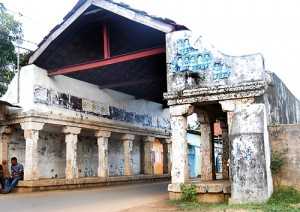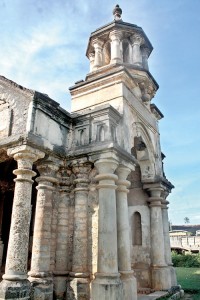Old memories, new realities
Jaffna, the centre of Sri Lanka’s Hindu Tamil culture, was in ancient times quite crucial to trade between Sri Lanka and the rest of the world. Scattered all over Jaffna today are relics which proclaim the ancient prominence of the city.

Manalkadu Dutch Church
We were going in search of Jaffna: of old memories as well as of new realities.
After a long journey of nearly 10 to 12 hours, we reached the city at night. Our lodgings were basic, but inside at the foot of several statues of Ganesh, were clay lamps which twinkled creating tranquility. Dinner was pittu with a sambol made of tiny fish- a Jaffna specialty.
The next morning we headed to the Old Dutch fort, replete with ramparts, ditches and all features of a good fort. Inside we saw old cannon, hidden passageways and even the chaplain’s house also parts of the chapel.

Thirumudai Ambalama
Conservation is being done by the Archaeological Department in a project half funded by the Dutch.
Our next stop was the Yamuneri pond, built in the time of the Arya Chakravarti kings. It had catered to the royalty of the peninsula in the distant past, and is now partially conserved.
“Sangili Thoppu” in Nallur is the entrance to the palace of the last king of Jaffna, of which only this entrance remains. The Dutch are also said to have used the old palace.
The Manthiri Manai, which is in nearby Nallur, is believed to have been the residence of King Sangili (1519-1561). It has an aura of grandeur with its stout walls and a few rooms, upstairs and downstairs, kitchen and the old well still to be seen.

Sangilian Manthiri Palace
The next day it was off to Kayts to see the old fort built out of coral. Passing by the Vadamaarachchi East Divisional Secretariat, we saw potsherds which were dispersed over a large area of land- an indication of a prehistoric settlement.
The Manal Kaadu Dutch church near Point Pedro built out of coral as well as of stone and brick is another ‘must-see’, though much of it is in ruins.
The “Thirumudi Madam” (the resting place or ‘ambalama’ in Thirumudi) is found near the Pasupatheeswarar kovil in Point Pedro. It is actually built on either side of the main road, with its roof arched over the road.

Kantharodai stupas
Our next stop was at Nilavarai, a well said to have ‘no bottom’ according to Philippus Baldaeus, a Dutch minister who lived in Jaffna.
The third day we were at the Naguleshvaram kovil, said to be built in the time of Arya Chakravarti 13. This shrine is a ‘holy of the holies’, one of the oldest shrines of the region. It is the northernmost of the five ancient ‘iswarams’ of Lord Siva which have been venerated by Hindus across the world from antiquity. Destroyed by the Portuguese, it was rebuilt in 1891 by the British. The original friezes are still intact.
The Sirappar Ambalama, built at the same time as the kovil, is interestingly the biggest ambalama in Sri Lanka. It had formerly a kitchen, store rooms, and chambers, though much of it has now succumbed to age.
Another part of the kovil is the Keerimalai pond, which since ancient times has been attributed with healing properties. During our visit we witnessed pilgrims and travellers from all over the country bathing in this ancient pond, now protected by the Archaeology Department.
The most important of Buddhist relics is at Kadurugoda or Kantharodai, uncovered by Paul E. Pieris in 1917. He had expressed his belief that the stupas here contain sacred relics of Lord Buddha. No less than 48 small stupas are under the care of the Archaeology Department and the Sri Lanka Army.

An old building being used as a market today
Taking the boat which plies free of charge, we made the one-hour journey to Delft and then got on a small lorry to discover the island. Amidst the old buildings built by the Dutch as their administrative centre, we saw a quaint object: a dovecote used for carrier pigeons.
The Delft Fort, also built by the Dutch, is a spectacular building, with old prison cells still visible. There is also a Buddhist site in Delft, little visited, but quite intriguing as it has a number of stupas. Delft also has its own lighthouse, called Queen’s Tower, built by the Dutch, standing 55 feet tall.
The famous Baobab in Delft produces fruit much sought by the monkeys on the island. Brought over by Arabs to provide food for their horses, there are only a few Baobab trees now left.
Our last evening in Jaffna was spent at the museum. Named after the great Hindu pundit Arumuga Navalar, it houses many artifacts found in the North. Officials including Vasana Malwenne of the Colombo Archeological Department and Arun and Wijenaike of the Jaffna Archaeology office, were most helpful in providing information.
As we left the North, we saw a couple placing a wreath by the statue built for that greatest of our war heroes, Hasalaka Gamini: Jaffna is finally witnessing blooms of peace after such a long war.


